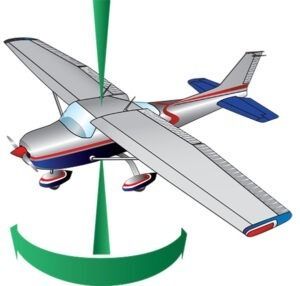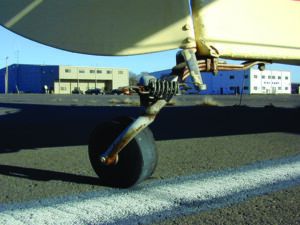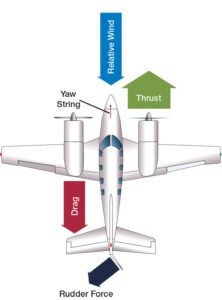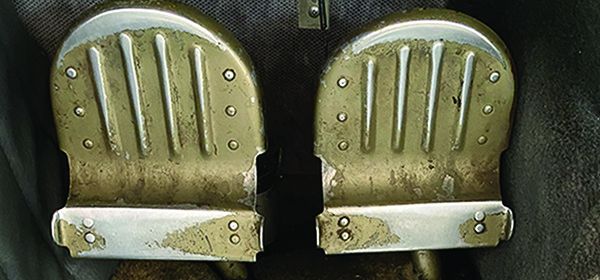If there’s anything I wish I could do for aspiring pilots or those struggling through their basic training, it would be to teach them to fly an airplane before learning to drive a car. The two-dimensional thinking employed when operating a surface vehicle becomes dominant—probably because we spend more time in a car than in an airplane—and often doesn’t translate well into the three dimensions required to fly. Oddly enough, it’s not that pilots don’t readily grasp the vertical (up/down) dimension; they do, along with the horizontal (left/right). But adding lateral movement (yaw) sometimes is too much for their two-dimensional thinking to handle.
The result is poor understanding of what the rudder pedals are for and how to use them. Sure; pedal-mounted brake controls are easy to grasp, since they’re something that translates from an automobile to a cockpit. But using only one rudder pedal at a time—as when countering torque and P-factor on a takeoff—can be elusive. And let’s not ruin a student’s confidence by diving into adverse yaw, slips and crosswind landings on the first lesson.
One way I’ve found to overcome the tendency for primary students to think in two-dimensional terms is to stress that proper use of the rudder pedals is determined by whether their feet are “happy,” by which I mean an active and coordinated part of all the pilot’s control inputs. Put another way, if the feet aren’t happy and active on the rudder pedals, the student is doing something wrong.

We know, or should know, that the rudder is used to manage yaw, the airplane’s motion around its vertical axis as determined by its center of gravity. Yaw occurs whether the airplane is airborne or taxiing, but it’s always managed with the rudder.
Yaw is induced any time we accelerate or decelerate, or pitch the nose up or down. It’s also produced when the airplane banks, and one wing develops more lift than the other, altering the drag each produces.
Except when in undisturbed straight-and-level flight, the airplane is always yawing to one extent or another, and the only consistent, reliable way to manage this yaw is with the rudder.
Since managing yaw can be a full-time job, our feet need to remain active, even though movement may be slight. If we’re doing it right, we learn to anticipate yaw, like when taking off and any time airspeed is changing.
ON THE GROUND
It starts on the ground, of course. Presuming a tricycle-gear airplane with steerable nosewheel, the basic concepts are easy: mash the left rudder pedal to turn left. Do the opposite to turn right, and center them both to move straight ahead. To stop, press the tops of the pedals at the same time, modulating the inputs to stay straight. These are relatively easy concepts for the primary student to embrace, but only the braking portion transfers directly from driving a car.
Steering with your feet definitely is an acquired skill, sometimes complicated by simultaneous but unwitting use of steering input and braking. When both braking and steering are needed, by all means use them both. But that’s rare away from tight ramp areas. Taxi speed is an important factor here, also: too much speed, usually thanks to using too much power, can require steering and braking at the same time, but it’s poor technique and makes it even more difficult to separate the two rudder-pedal functions from each other.
On the other hand, taxiing can be a great opportunity to train a student on coordinated rudder use. The idea is to taxi slowly enough that minimal steering input is needed. This requires a relatively calm day and smooth pavement, but neither are that hard to find in most locations. This would seem in opposition to my desire to keep the feet moving, but really isn’t, as no rudder-pedal input is needed. Keeping the feet happy only applies when necessary for control. While taxiing, the connection between on-ground and in-air rudder input can be emphasized by reference to the turn coordinator/turn and bank instrument and how it reacts.

In the air, a taildragger is just another airplane. The fun begins when trying to put it on the ground, and taxiing once it’s there. If any operation demands that we be “happy” on the rudder pedals, this is it.
The problem, if there is one, is twofold: First, pilots transitioning to a taildragger from a nosedragger aren’t sensitized to how easily the former can swap ends without much warning. Second, they don’t recognize the warning, and often don’t apply enough rudder to correct and compensate when they do.
If a pilot of a tricycle-gear airplane has good directional control on the ground, they’re likely to have it in a taildragger, also. Teaching them the different sensations—the seat of the pants feel—taildraggers bring to the operation typically is easy enough, but if they don’t have the respect for and skills required to taxi straight in the first place, it can be a challenge.
TRANSITION TO/FROM FLIGHT
Adding takeoff power to a basic taxi operation can highlight for the student how the rudder pedals are used to manage yaw when airborne, if not its source. The need to establish and maintain directional control becomes a primary goal during a takeoff, perhaps becoming acute when crosswinds are involved. Another lesson to be gained here is the need for smooth application of power, along with coordinated rudder input. If the power application and rudder input are both slow enough and closely coordinated, the nose never really deviates from its alignment with the runway centerline.
Of course, the faster the airplane moves during the takeoff, the less rudder is needed until the nose pitches up slightly and a climb attitude is established. When the nose pitches up, additional rudder is required to keep the nose straight.
The rudder input’s quality can be measured in a couple of ways. One is the airplane’s own heading instruments. Another is to pick a cloud or other distant feature and gauge the extent to which, if any, the nose deviates from its relationship to that feature.
Presuming wind is right down the runway, landing presents a much different lesson. For one, there’s no need to counter the effects of torque and P-factor as on takeoff and climb. There may be a slight need for corrective rudder in the flare as the nose pitches up, but it’s gentle.
Crosswinds are different, of course, especially when landing. But the need to keep the feet happy and use them to align the airplane’s nose with the runway centerline isn’t. In many crosswind situations, keeping the nose pointed where we want it during landing and rollout will require roughly as much rudder input and coordination as a takeoff.
AIRSPEED CHANGES
Typical cruise flight in a well-rigged and trimmed airplane means little to no rudder input while an occasional drooping wing can easily be raised with a touch of opposite rudder. Otherwise, the happy feet can remain flat on the floor. Pitch the nose over, however, and things change. As airspeed builds, the typical personal airplane will require rudder input opposite than what’s needed during takeoff and climb to keep the nose straight.
If we wanted to transfer that airspeed into climb rate, both feet will need to be happy, first to counter the higher airspeed, then to neutralize the rudder, and then back to the kind of high-power, low-airspeed inputs made on takeoff and climb. This type of exercise is especially useful when demonstrating performance maneuvers, like those required for the commercial certificate.
As always, the emphasis should be on keeping the feet active on the rudder pedals—happy—and coordinating their input with the other flight controls.

For the most part, keeping the typical airplane pointed where we want doesn’t require full rudder-pedal travel. There are exceptions to this “rule,” most notably when flying a multiengine airplane on one engine and, especially, when conducting a VMC demonstration. In fact, the VMC demo is completed and the configuration recovered when full rudder is applied.
Other occasions where all available rudder is required can include full-power application for the takeoff roll and when performing a crosswind landing (although we don’t recommend getting so deep into either maneuver that full rudder is required).
STALLS AND YAW
There’s a word for a stall that incorporates a yawing moment: It’s called a spin, and when performed at the wrong time and place, often results in yet another entry in the loss-of-control accident statistics. This is another reason it’s important to actively manage yaw.
Learning how to manage yaw, especially at low airspeeds, begins on the ground, which is where we learn a healthy stab of the foot at the right time will keep the airplane aligned with the runway, or the wings level, and minimize any tendency to slip or skid.
STAYING HAPPY
Note that one aspect of rudder use I haven’t focused on is turns and banks. That’s because if we can nail the other maneuvers when timely rudder application is important, how to coordinate turns with rudder will almost be an afterthought. Keeping the airplane headed where you want isn’t that hard if you’re attuned to its rudder effectiveness.
Mike Stevens is an instrument-rated commercial pilot flying for a Part 135 air taxi operation.




